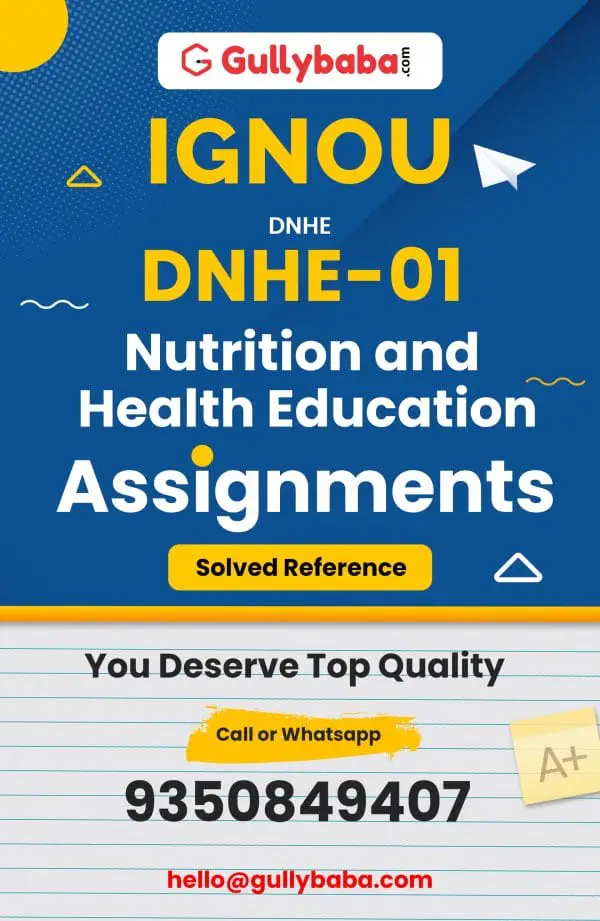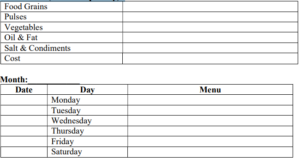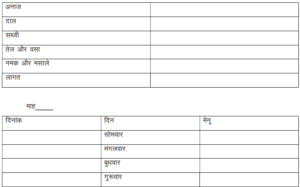IGNOU DNHE-01 (January 2025 – July 2025) Assignment Questions
Part A: Descriptive Type Question
All questions are compulsory
1. a) Elaborate the various functions of food.
b) Describe the functions of carbohydrates. Briefly explain the process of digestion of carbohydrates.
2. a) Enumerate the functions of proteins and fats in our body.
b) Differentiate between water soluble and fat soluble vitamins, giving examples.
3. a) What are the factors influencing the absorption of iron in the body?
b) Briefly explain the guidelines you will use to plan balanced diets.
4. a) Discuss the concept and aims of meal planning. Identify the factors that need to be considered in meal planning.
b) How will you estimate energy requirements of an adult man?
5. a) What are the nutrient requirements during the last trimester of pregnancy? Give the RDA.
b) What is ARF ? Why do we use ARF in the context of complementary feeding?
6. a) Discuss the major considerations you will keep in mind while feeding adolescents.
b) What points would you consider to bring about economy in food budgeting?
7. a) Give the classification of food based on perishability. Give examples of food in each category.
b) Differentiate between food contamination and food adulteration, giving examples.
8. a) Enlist the causes and preventive measures of the following nutritional deficiency disorders:
(i) Anaemia
(ii) Vitamin A deficiency.
b) What are the clinical features of the deficiency of Vitamin D in children and in adults?
9. Discuss the clinical features and dietary management of the following disorders:
(i) Obesity
(ii) Hypertension
(iii)Diarrhoea
10. a) List any two welfare programmes implemented by the Government for children. Describe their objectives and components.
b) What do you understand by the terms ‘Growth monitoring’ and ‘Growth faltering’?
Section B – Application Question (AQ)
1 Suvarna is pregnant. She has been asked by her doctor to eat energy/ protein rich snacks (providing at least 500 kcal energy and 8-10 gm protein per serving) in between the main meals. Given below are names and ingredients of some snacks gathered by her from the various resources. Using the food composition tables, calculate the energy and protein content of these snacks and indicate which of them is suitable / not suitable for her.
(i) Besan-spinach cheela (Besan-50 g, spinach-50 g, onion-30 g, oil-10 g)
(ii) Bread roll (Bread 2 large pieces (60 g), potato- 60 g, onion-20 g, oil 20 g)
(iii) Idli sambhar (Rice-25 g, Urad dal-10 g, Arhar dal-10 g, onion-10 g, carrot-10 g, oil-5 g)
Use the following proforma to record your results for each of the recipe:
Name of the Dish- Besan Spinach cheela / Bread roll / Idli sambhar
Total energy content________ kcal, Total protein content________ gm.
The dish is suitable/not suitable for Suvarna (put a tick mark against the right choice)
(Refer to DNHE 1, Vol 2, Practical Manual -Part 1, Section 2)
2. Based on the steps involved in planning balanced diet, prepare a diet for a moderately active man belonging to low socio-economic group. (Refer to DNHE 1, Vol 2, Practical Manual – Part 1, Section 6-Planning Diet-II)
3. Piyush is the son of Mohinder Singh and Rajwati. He was born on 2nd July 2023. His weight in different months was as follows:
July 3.3 kg
August 4.0 kg
September 4.8 kg
October 5.3 kg
November 5.8 kg
December 6.0 kg
Plot these weights on the growth chart. What is the direction of growth curve from birth until December 2023? What would you tell Piyush’s mother during this time? (Refer to DNHE 1 Vol 2, Unit 25)
4. Visit a primary school in your area providing Mid Day Meal to primary grade students. Collect information regarding the cyclic menu, nutritional norms and cost per child for the menu being supplied at the School. Comment on the nutritional adequacy of the menu being supplied in the Mid-day meal and also give your suggestions on how to improve the menu. Record your observations in the format given below:
Name of the School:____________
Grade:_______
Nutritional Norms: Energy__________ kcal , Protein ________ gm
Food Norms (Per Child per day):
IGNOU DNHE-01 (January 2024 – July 2024) Assignment Questions
Part A: Descriptive Type Question
1. a) Define nutrition and health. Elaborate interrelationship between nutrition and health.
b) Enumerate the functions and sources of available and non-available carbohydrates.
2. Enlist the food sources and enumerate the functions of the following vitamins:
a) Vitamin A
b) Vitamin D
c) Vitamin K
3. a) What points would you keep in mind while planning a balanced diet for pregnant woman?
b) Explain in brief the various factors which influence calcium absorption.
c) Define RDA. Why safety margin is added in requirement to calculate RDA?
4. a) Write a note on physiological changes during pregnancy.
b) Define complementary feeding. Enlist the benefits of breastfeeding.
5. Enumerate any 3 criteria for selection of each of the following foods:
a) Pulses
b) Flesh foods
c) Fruits
6. a) What is food spoilage? Explain the causes of food spoilage.
b) Elaborate various methods to enhance nutritive value of foods.
7. a) What are the clinical features of Vitamin A deficiency?
b) Give the etiology and clinical features of the following deficiency diseases:
i) Ariboflavinosis
ii) Pellagra
8. a) What are the risk factors of Coronary heart Diseases?
b) Describe principles of treatment of obesity.
9. Explain briefly:
a) MUAC and BMI
b) Diet survey
c) Growth monitoring
10. a) Write about the objectives and components of ICDS Programme.
b) Give objectives, target groups and dose distribution strategy of NIPI programme.
Section B – Application Question (AQ)
1. Based on the steps involved in planning balanced diet, prepare a diet for a sedentary lactating mother belonging to low socio-economic group. (Refer to DNHE 1, Vol 2, Practical Manual – Part 1, Section 6-Planning Diet-II)
2. Record height and weight of 10 (ten) college going girls/boys (18-23years) in your locality and determine their body mass index (BMI). Classify them to identify their health status based on WHO classification (Refer to DNHE 1 Vol 2, Unit 21, Table 21.1)
3. Visit your locality and identify 10 infant (age: 6 Months-12months) on complementary feeding. In a table record their name, age, gender and the complementary foods introduced to them by their mothers. Analyse whether their diet is in accordance to dietary recommendations suggested for them. (Refer to DNHE 1 Vol 1, Unit 9)
4. Write recipes of any two vegetable dishes prepared at your home. Identify and highlight prepreparation and cooking methods involved in it. Give description/nutritional value of identified pre- preparation and cooking methods. (Refer to DNHE-1, Vol 1, Unit-11)
IGNOU DNHE-01 (January 2025 – July 2025) Assignment Questions
भाग क: वर्णनात्मक प्रश्न
1. (क) भोजन के विभिन्न कार्यों की व्याख्या कीजिए।
(ख) कार्बोज के कार्यों का वर्णन कीजिए। कार्बोज के पाचन की प्रक्रिया को संक्षेप में समझाइए।
2 (क) हमारे शरीर में प्रोटीन और वसा के कार्यों का वर्णन कीजिए।
(ख) उदाहरण देते हुए जल में घुलनशील और वसा में घुलनशील विटामिन के बीच अंतर बताइए।
3. (क) शरीर में लौह तत्व के अवशोषण को प्रभावित करने वाले कारक कौन से हैं?
(ख) संतुलित आहार की योजना बनाने के लिए आप जिन मार्गदर्शी निर्देशों का अनुसरण करेगे, उनका वर्णन कीजिए।
4. (क) भोजन योजना की संकल्पना और उद्देश्यों को चर्चा करें। आहार आयोजन को प्रभावित करने वाले कारको के बारे में जानकारी दीजिए।
(ख) आप एक वयस्क पुरूष की ऊर्जा आवश्यकताओं का अनुमान कैसे लगाएंगे (
5. (क) गर्भावस्था के अंतिम तिमाही के दौरान पोषक तत्वों की आवश्यकताएं क्या हैं? आर.डी.ए. दें कर बताए।
(ख) ए.आर.एफ. क्या है? पूरक आहार के संदर्भ में हम ए. आर.एफ. का उपयोग क्यों करते हैं?
6. (क) किशोरों को आहार देते समय ध्यान रखने योग्य प्रमुख बातो की चर्चा करें।
(ख) खाद्य बजट में किफायत लाने के लिए आप किन बातो को ध्यान में रखेगे?
7. (क) खाद्य पदार्थों के खराब होने के आधार पर खाद्य पदार्थों को वगीकृत कीजिए। प्रत्यके वर्ग के खाद्य पदार्थों का उदाहरण दीजिए।
(ख) उदाहरण देते हुए खाद्य संदूषण और खाद्य अपमिश्रण के बीच अन्तर बताइए।
8. (क) निम्नलिखित पोषणहीनता जन्य रोगों के कारणों और रोकथाम के उपायों को सूचीबद्ध कीजिए:
i) एनीमिया
ii) विटामिन ए की कमी।
(ख) बच्चों और वयस्कों में विटामिन डी की कमी के नैदानिक लक्षण क्या हैं
9. निम्नलिखित विसंगतियों के नैदानिक लक्षणों और आहार व्यवस्था पर चर्चा करें:
i. मोटापा
ii. उच्च रक्तचाप
iii) अतिसार
10. (क) सरकार द्वारा बच्चों के लिये चलाये गये किन्हीं दो कल्याणकारी कार्यक्रमों को सूचीबद्ध कीजिए। उनके उद्देश्यों और घटकों का वर्णन कीजिए।
(ख) वृद्धि अनुवीक्षण और ‘वृद्धि अवरोधन’ शब्दों से आप क्या समझते हैं
भाग ख- प्रयोगात्मक अभ्यासय
1. सुवर्णा गर्भवती है। उसे डॉक्टर ने मुख्य आहरों के बीच में अधिक ऊर्जा प्रोटीन से युक्त अल्पाहार (कम से कम 500 किलो कैलोरी ऊर्जा और 8-10 ग्राम प्रोटीन प्रति सर्विंग प्रदान करता हो) खाने को कहा है। नीचे उसके द्वारा विभिन्न संसाधनों से उसके द्वारा एकत्र किए गए कुछ अल्पाहारो के नाम और सामग्री दी गयी हैं। खाद्य संरचना तालिका का उपयोग करकेए इन अल्पाहारी की ऊर्जा और प्रोटीन की मात्रा ज्ञात करें और बताइए कि उनमें से कौन सा उसके लिए उपयुक्त / उपयुक्त नहीं है।
i. बेसन-पालक चीला (बेसन-50 ग्राम, पालक-50 ग्राम, प्याज-30 ग्राम, तेल-10 ग्राम)
ii. ब्रेड रोल (ब्रेड 2 बड़े पीस (60 ग्राम), आलू 60 ग्राम, प्याज-20 ग्राम, तेल 20 ग्राम)
इडली सांभर (चावल-25 ग्राम, उड़द दाल 10 ग्राम, अरहर दाल-10 ग्राम, प्याज-10 ग्राम, गाजर-10ग्राम, तेल-5 ग्राम)
अपने परिणाम को लिखने के लिए निम्नलिखित प्रोफार्मा का उपयोग करेंरू
ऊर्जा की कुल मात्रा किलो कैलोरी, कुल प्रोटीन की कुल मात्रा ग्राम।
यह व्यंजन सुवर्णा के लिए उपयुक्त/अनुयुक्त है (सही विकल्प के आगे का निशान लगाइए)
(डी.एन.एच.ई 1, Vol 2, प्रैक्टिकल मैनुअल पार्ट 1, सेक्शन 2 देखें)
2. संतुलित आहार की योजना बनाने में शामिल चरणों के आधार पर, निम्न सामाजिक-आर्थिक समूह से संबंधित मध्यम श्रम करने वाले पुरूष के लिए आहार योजना तैयार करें। (डी.एन.एच.ई 1, खंड 2, प्रैक्टिकल मैनुअल भाग 1, सेक्शन 6-आहार. नियोजन || देखें)
3. पीयूष मोहिंदर सिंह और राजवंती का बेटा हैं। उसका जन्म 2 जुलाई 2023 को हुआ था। अलग.अलग महीनों में उसका वजन इस प्रकार था
जुलाई 3.3 किलो
अगस्त 4.0 किलो
सितंबर 4.8 किलो
अक्टूबर 5.3 किलो
नवंबर 5.8 किलो
दिसंबर 6.0 किलो
इन भारों को वृद्धि चार्ट पर अंकित कीजिए। जन्म से दिसंबर 2023 तक वृद्धि की क्या दिशा है? इस दौरान आप पीयूष की मां को क्या कहेंगे? (डी.एन.एच.ई 1 वॉल्यूम 2. इकाई 25 देखें)
4. प्राथमिक कक्षा के छात्रों को मध्याह्न भोजन प्रदान करने वाले अपने क्षेत्र के एक प्राथमिक विद्यालय में जाएँ। स्कूल में प्रदान किए जा रहे भोजन के चक्रीय मेनू, पोषण मानदंडों और प्रति बच्चे की लागत के बारे में जानकारी एकत्र करें। मध्याह्न भोजन में दिए जा रहे मेनू की पोषण पर्याप्तता पर टिप्पणी करें और मेनू को बेहतर बनाने के बारे में अपने सुझाव भी दें। अपने अवलोकन को नीचे दिए गए प्रारूप में लिखिएः
स्कूल का नाम :
कक्षा :
पोषण मानदंडःऊर्जा किलो कैलोरी, प्रोटीन ग्राम
खाद्य मानदंड (प्रति बच्चा प्रति दिन):
IGNOU DNHE-01 (January 2024 – July 2024) Assignment Questions
भाग क : वर्णनात्मक प्रश्न
1) क) पोषण और स्वास्थ्य को परिभाषित करें। पोषण और स्वास्थ्य के बीच अंतर्संबंध को विस्तार से बतायें। (3)
ख) उपलब्ध और गैर- उपलब्ध कार्बोहाइड्रेट के कार्यो और स्रोतों का वर्णन करें।
2) निम्नलिखित विटामिनों के खाद्य स्रोतों को सूचीबद्ध करें तथा उनके कार्यों का वर्णन करें।
क) विटामिन ए
ख) विटामिन डी
ग) विटामिन के
3) क) गर्भवती महिला के लिए संतुलित आहार की योजना बनाते समय आप किन बातों को ध्यान में (2) रखेंगे?
ख) कैल्शियम अवशोषण को प्रभावित करने वाले विभिन्न कारकों को संक्षेप में समझाइए ।
ग) आरडीए को परिभाषित करें। आरडीए की गणना करने के लिए आवश्यकता में सुरक्षात्मक मात्रा क्यों जोड़ा जाता है?
4) क) गर्भावस्था में होने वाले शारीरिक परिवर्तनों पर एक नोट लिखें।
ख) पूरक आहार को परिभाषित करें। स्तनपान के लाभों को सूचीबद्ध करें।
5) निम्नलिखित खाद्य पदार्थों में से प्रत्येक के चयन के लिए किन्हीं 3 मापदंडों का वर्णन करें:
क) दालें
ख) मांस व मांस से बने पदार्थ
ग) फल
6) क) खाद्य पदार्थो का खराब होना क्या है? खाद्य पदार्थों के खराब होने के कारणों को स्पष्ट कीजिए । (1+2)
ख) खाद्य पदार्थों के पोषक मूल्य को बढ़ाने के लिए अपनाये जाने वाले विभिन्न तरीकों को विस्तार से लिखें ।
7) क) विटामिन ए की कमी के नैदानिक लक्षण क्या हैं?
ख) पोषक तत्वों कमी से हाने वाले निम्नलिखित रोगों के कारणों और नैदानिक लक्षणों को बतायें।
i) राइबोफ्लेबिन हीनता
ii) पेलेग्रा
8) क) हृदय धमनी संबधी रोग के खतरे के कारक क्या हैं?
ख) मोटापे के उपचार के सिद्धांतों का वर्णन कीजिए ।
9) संक्षेप में समझाएं:
क) एम यू ए सी और बी एम आई
ख) आहार सर्वेक्षण
ग) वृद्धि अनुवीक्षण
10) क) आईसीडीएस कार्यक्रम के उद्देश्यों और घटकों के बारे में लिखिए।
ख) एनआईपीआई कार्यक्रम के उद्देश्य, लक्ष्य समूह और खुराक वितरण प्रणाली को बताएं ।
भाग ख – प्रयोगात्मक अभ्यास
1) संतुलित आहार की योजना बनाने में शामिल चरणों के आधार पर कम सामाजिक-आर्थिक समूह से संबंधित एक अल्प श्रम करने वाली स्तनपान कराने वाली मां के लिए आहार योजना तैयार करें। (DNHE 1, भाग-3 प्रयोगात्मक कार्यो की नियमावली भाग 1, भाग-6 आहार नियोजन – ॥ देखें)
2) अपने क्षेत्र के 10 (दस) कॉलेज जाने वाली लड़कियों / लड़कों ( 18-23 वर्ष) की ऊंचाई और वजन रिकॉर्ड करें और उनका बॉडी मास इंडेक्स (बीएमआई) निर्धारित करें। डब्ल्यूएचओं वर्गीकरण के आधार पर उनकी स्वास्थ्य स्थिति की पहचान करने के लिए उन्हें वर्गीकृत करें ( DNHE 1, भाग-2 इकाई-21, तालिका 21.1 देखें) ।
3) अपने क्षेत्र के 10 शिशु (आयु 6 महीने – 12 महीने ) की पहचान करें जिन्हें पूरक आहार दिया जा रहा है। एक तालिका में उनका नाम, आयु, लिंग और उनकी माताओं द्वारा उन्हें दिये गए पूरक खाद्य पदार्थ रिकॉर्ड करें। विश्लेषण करें कि क्या उनका आहार उनके लिए सुझाए गए आहार सिफारिशों के अनुसार है। भाग -1 इकाई 9 देखें)
4) अपने घर पर तैयार किए गए किन्हीं दो सब्जी व्यंजनों की रेसिपी लिखें। इसमें शामिल पूर्व तैयारी और खाना पकाने के तरीकों को पहचानें और रेखांकत करें। पहचान की गई पूर्व तैयारी और खाना पकाने के तरीकों का विवरण / पोषक मूल्य बतायें। (DNHE 1, भाग – 1, इकाई 11 देखें)













